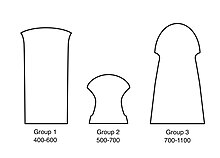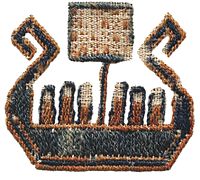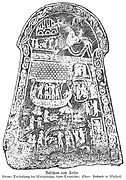Gotland picture stones
Gotland picture stones ( Swedish : bildstenar or billedstenar ) is the name for high stones with pictorial representations on Gotland in Sweden from the 5th to 14th centuries. So far 442 picture stones are known, a few of them in neighboring regions ( Öland , Kurland ).
description
The stones are between 50 and 350 centimeters high. They are provided with figurative and schematic representations and with some rich ornaments. Some representations are now completely weathered and no longer recognizable. Some stones were discovered in their original locations, others were in medieval churches or had been used in some other way.
prehistory
The starting point of the picture stones cannot be clarified. The local stone tradition and impulses from continental Europe could have played a role, but nothing speaks against a completely independent development that already took place on Gotland when the ships were being set . There are parallels among Roman tombstones in Spain . These also show individual carvings in the Mälar area , above all the stone from Häggeby, (U664) in Uppland, with the depiction of a rowing ship and a stallion hunt .
In Central Europe there is only one parallel to the figural representation of the picture stones. The equestrian stone from Hornhausen , in Saxony-Anhalt , which can be assigned to the early 7th century due to its animal ornamentation, can be compared with a presumably simultaneous, Uppland depiction. Both are reminiscent of corresponding motifs on Gotland. Even recent Pictish picture stones from Scotland have equestrian images that are reminiscent of Gotlandic representations. Late Gothic picture stones are similar to the figurative continental rune carvings and the most recent examples are themselves rune stones in the form of picture stones (G 135 by Sjonhem). The tapestries from Överhogdal, in Härjedalen (Sweden) with numerous figurative representations and, to a certain extent, the carpet from Oseberg, (Norway) , show that art was not only there on Gotland's picture stones, but also flourished on textiles .
The representations can also be found on the stones of the grave boxes . The monuments occurring from the 6th to the 12th century AD disappear in their older form with Christianization. These monuments were found in pagan cemeteries on Gotland and in churches on the mainland (presumably relocated there).
Dating
The dating of the oldest picture stones to the 5th century was secured in 1979 by the archaeologist Karin Äijä , who discovered a grave in the cemetery of Uddvide (Barshaldershed) in the parish of Grötlingbo , in the boundary of which a stone that was broken during processing was built into. This must be at least as old as the tomb and the objects it contains. The grave contained fibulae from the 5th century.
Types
- Type 1, AD 400–600: high stones with a slightly convex upper edge and slightly inwardly curved sides, broadened axially at the top. The representations are decorated exclusively geometrically and ornamentally. Motifs are often a whirl wheel surrounded by animals or multiple spirals .
- Type 2, 500–700 AD: low stones ("dwarf stones", approx. 50 to 75 cm), ax-shaped. The representations are scratched as outlines and use representational elements for the first time: animal motifs (birds), sailing ships.
- Examples: Bildstein from Priediens , Bildstein from Smiss (Garda)
- Type 3, 700–1100 AD: high stones (approx. 270 to 320 cm), with a trapezoidal trunk and a rounded head (phallic). The representations are designed as reliefs. They show pictorial scenes in several rows: battle scenes, men on horses, some of whom are received by women with drinking horns, a large ship. The motifs can be attributed to the tradition of gods or heroes. There are rich decorations (for example, Valknut ).
- Examples: Bildstein from Ardre , Bildstein from Stora Hammars and Bildstein from Stenbro .
Other regions
Gotland picture stones were also found in neighboring regions.
Uppland
In 1632 the imperial antiquarian Johannes Bureus found three parts of a picture stone in the Norrsunda cemetery in Uppland . He and the prehistorian M. Aschaneus drew and published the stone, which then disappeared and was apparently used as a building material.
The stone has gotlandic shape and the runes make a statement about the origin. The translation of the damaged text reads: “... they brought this stone from Gotland. . . and after . .. his brother. He owned this… ”. The stone probably came from Gotland as a carved blank and was carved and runes in Uppland, as can be seen in the details of the ornament. At the base it was about 70 cm wide, and upright it was 1.4 m high.
Öland
Two finds from the church of Köping on Öland also speak in favor of the export of picture stones from Gotland . From the Viking Age trading center comes a stone of Gotland shape with incisions on both sides, as well as the lower part of a second apparently similar stone. The runes of the 92 cm high sandstone block do not speak of Gotland origin; the ornamentation also seems to be from the country. The dating was made to 1000–1100 AD.
The rune text is in translation: Asgot and (Torsten built this stone) for their father Öste.
Courland
The Priediens picture stone was found near Grobin in the Baltic Courland , dates back to the 7th century and is the oldest export. The stones from Kurland, Öland and Uppland are probably exported semi-finished products.
Pict stones in Scotland
In Europe there is another group of picture stones, the part of which shows primarily symbols, but sometimes also stands out from the area of symbolism, such as those shown by Scottish crosses or Irish pillar stones . There are also the Pict stones in Scotland .
- Gotland picture stones
Valknut , Stora Hammars I.
Bildstein, 800 AD, Ernstkirchen in Lower Franconia
See also
literature
- Erik Nylén , Jan Peder Lamm: Picture stones on Gotland. Wachholtz, Neumünster 1981, ISBN 3-529-01823-6 .
- Sigmund Oehrl: Gotland's picture stones. Problems and new ways of their documentation, reading and interpretation (= Studia archaeologiae medii aevi. 3). Likias Verlag, Friedberg 2019, ISBN 978-3-9820130-1-5 .
- Jan Peder Lamm: Bildstenar . Gidlunds förlag, 1987, ISBN 91-7844-087-4 .
Web links
- Description Engl. and pictures (PDF; 872 kB)











